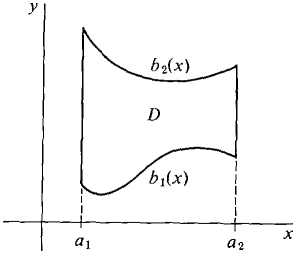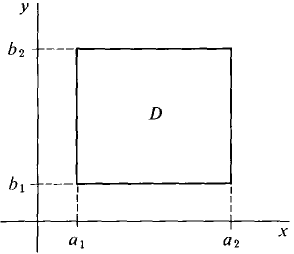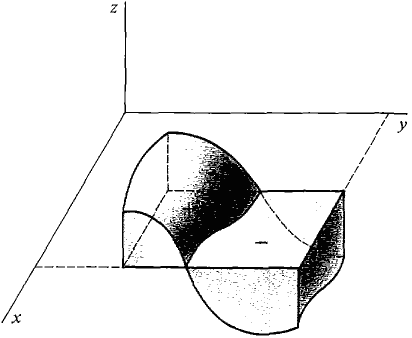| The ebook Elementary Calculus is based on material originally written by H.J. Keisler. For more information please read the copyright pages. |

|

Home  Multiple Integrals Multiple Integrals  Double Integrals Double Integrals  Closed Region on a Plane Closed Region on a Plane |
|






|
|
Closed Region on a Plane
We now begin the construction of the double integral, starting with a careful discussion of closed regions in the plane. A closed region in the (x, y) plane is a set D of real points (x, y) given by inequalities a1 ≤ x ≤ a2, b1(x) ≤ y ≤ b2(x), where b1(x) and b2(x) are continuous and b1(x) ≤ b2(x) for x in [a1, a2] (Figure 12.1.3(a)). The boundary of D is the set of points in D which are on the curves x = a1, x = a2, y = b1(x), y = b2(x).
Figure 12.1.3 (a) Closed region The simplest type of closed region is a closed rectangle a1 ≤ x ≤ a2, b1 ≤ y ≤ b2, shown in Figure 12.1.3(b). Figure 12.1.3 (b) Closed rectangle Remark In this course we are restricting our attention to a very simple type of closed region, sometimes called a basic closed region. In advanced calculus and beyond, a much wider class of closed regions is studied. An open region is a set of real points defined by strict inequalities of the form c1 < x < c2, d1(x) < y < d2(x). We shall usually be working with closed regions. So from now on when we use the word region alone we mean closed region. To simplify our treatment we shall consider only continuous functions. Permanent Assumption for Chapter 12If f(x, y) ≥ 0 on D, the double integral is intuitively the volume of the solid over D between the surfaces z = 0 and z = f(x, y); i.e., the solid consisting of all points (x,y, z) where (x, y) is in D and 0 ≤ z ≤ f(x, y). If f(x, y) ≤ 0 on D the double integral is intuitively the negative of the volume of the solid under D between the surfaces z = f(x, y) and z = 0. Thus volumes above the plane z = 0 are counted positively and volumes below z = 0 are counted negatively (Figure 12.1.4).
Figure 12.1.4
|
|
Home  Multiple Integrals Multiple Integrals  Double Integrals Double Integrals  Closed Region on a Plane Closed Region on a Plane |
|
Last Update: 2006-11-05




